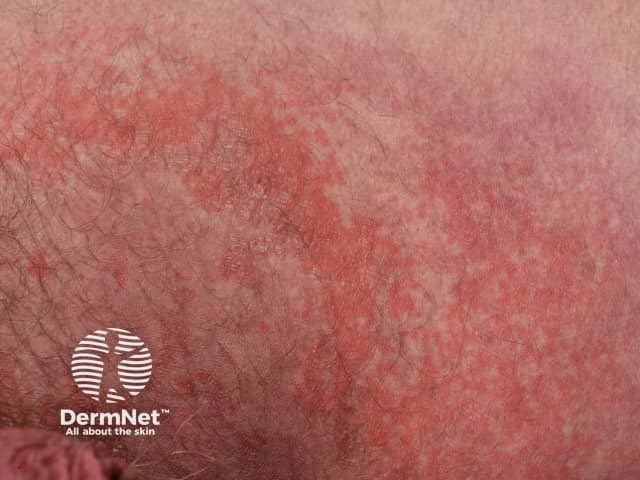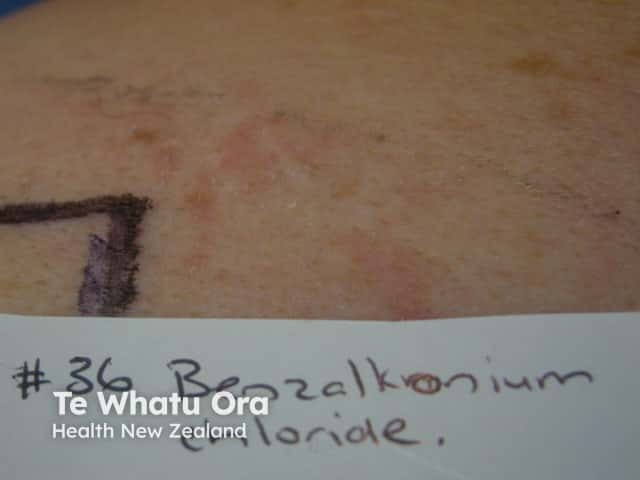Main menu
Common skin conditions

NEWS
Join DermNet PRO
Read more
Quick links
Authors: Dr Claire Felmingham, Research Fellow, Occupational Dermatology Research and Education Centre, The Skin Health Institute, Melbourne, VIC, Australia; A/Prof Rosemary Nixon, Dermatologist and Occupational Physician, Occupational Dermatology Research and Education Centre, The Skin Health Institute, Melbourne, VIC, Australia. DermNet Editor in Chief: Adjunct A/Prof Amanda Oakley, Dermatologist, Hamilton, New Zealand. Copy edited by Gus Mitchell/Maria McGivern. August 2019.
Introduction - benzalkonium chloride
Introduction - benzalkonium chloride contact dermatitis
Demographics
Products containing benzalkonium chloride
Clinical features
Diagnosis
Treatment
Benzalkonium chloride is an organic salt used in cleaning agents, classified as a quaternary ammonium cationic detergent. It can be used as an antiseptic and preservative in personal care, healthcare, household, pharmaceutical, and industrial products [1,2].
When benzalkonium chloride comes into contact with the skin, it can cause irritant contact dermatitis or allergic contact dermatitis in some individuals.
Benzalkonium chloride is a well-known irritant [1]. Irritant contact dermatitis due to benzalkonium chloride is more common than allergic contact dermatitis from its use.
Irritant contact dermatitis due to benzalkonium chloride can affect anyone. Allergic contact dermatitis can affect any individual who becomes sensitised or allergic to benzalkonium chloride.
Both irritant and allergic contact dermatitis due to benzalkonium chloride are more likely to occur in people with a compromised skin barrier, such as in people with atopic dermatitis (eczema).
Healthcare workers are also at greater risk of developing contact dermatitis to benzalkonium chloride, given the use of benzalkonium chloride use in sterilisation solutions and antiseptics and disinfectants in healthcare settings [2,3].
Benzalkonium chloride can be found in:
Both allergic and irritant contact dermatitis start at the site of contact with benzalkonium chloride. In prolonged or severe cases, dermatitis may spread to other sites [10,11]. The affected skin may be red, itchy, dry, or scaly, and may also blister or peel.
Symptoms may start to occur hours or days after contact with benzalkonium chloride. Some people may develop periorbital or eye dermatitis or conjunctivitis (red and itchy eyes) after the use of ophthalmic solutions containing benzalkonium chloride [1].
A small subset of people exposed to benzalkonium chloride may develop a rash called granular parakeratosis [4]. Granular parakeratosis is a red or brown patchy and scaly rash that most commonly affects skin folds such as the armpits and groin. As the skin heals, it might peel [12].
It is thought that, in addition to being provoked by occlusion, friction, and sweating, granular parakeratosis can also be provoked by contact with benzalkonium chloride. People with atopic dermatitis are predisposed to this condition [4,12].

Granular parakeratosis due to contact with benzalkonium chloride
Patch testing is used to diagnose allergic contact dermatitis (type IV/delayed hypersensitivity) to benzalkonium chloride. Benzalkonium chloride is included in the Australian Baseline Series and New Zealand Baseline Series for patch testing (tested as benzalkonium chloride 0.1% aqueous) [13].
Doubtful or weakly positive patch test reactions to benzalkonium chloride should be interpreted cautiously. These weak positive reactions may represent irritant reactions, rather than allergic reactions [5,14].
The open application test may also be useful to confirm reactions [14].

Borderline patch test reaction to benzalkonium chloride
Once the diagnosis of contact dermatitis is confirmed, it is important to avoid contact with any product containing benzalkonium chloride. The affected individual should be aware of the types of products that can contain benzalkonium chloride and should carefully read product ingredient labels.
The avoidance of benzalkonium chloride along with treatment for the acute dermatitis usually results in resolution of the rash over weeks.
In cases of contact allergy, it is likely that the individual will remain allergic to benzalkonium chloride indefinitely, or at least for many years.
Benzalkonium chloride can cross-react with other quaternary ammonium compounds (preservatives), such as behentrimonium methosulfate, cetrimonium (cetrimide) chloride, and benzethonium chloride [5]. If someone is found to have allergic contact dermatitis to benzalkonium chloride, they should avoid the following ingredients as well:
Active dermatitis can be treated, as with any acute eczema/dermatitis, with: